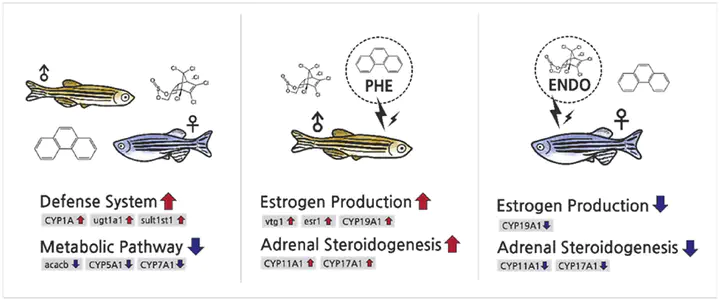Combined toxicity of endosulfan and phenanthrene mixtures and induced molecular changes in adult Zebrafish (Danio rerio)

Abstract
Individual and combined toxicities of endosulfan (ENDO) with phenanthrene (PHE) were evaluated using zebrafish (Danio rerio) adults. The 96-h LC50 values for ENDO and PHE were 4.6 μg L−1 and 920 μg L−1, respectively. To evaluate the mixture toxicity, LC10 and LC50 concentrations were grouped into four combinations as ENDO-LC10 + PHE-LC10, ENDO-LC10 + PHE-LC50, ENDO-LC50 + PHE-LC10, and ENDO-LC50 + PHE-LC50, and their acute toxicities were determined. The combination of LC50-ENDO and LC10-PHE exhibited a synergistic effect. In addition, acetylcholinesterase activity decreased in zebrafish bodies exposed to ENDO with or without PHE. Combined treatments induced higher glutathione S-transferase activity compared to individual treatments. Carboxylesterase activity increased in both heads and bodies of ENDO-treated fishes compared with PHE-treated fishes. Using RT-qPCR technique, CYP1A gene expression significantly up-regulated in all combinations, whereas CYP3A was unchanged, suggesting that enzymes involved in defense may play different roles in the detoxification. CYP7A1 gene responsible for bile acid biosynthesis is dramatically down-regulated after exposure to the synergistic combination exposure, referring that the synergistic effect may be resulted from the reduction of bile production in zebrafishes. Among gender-related genes, CYP11A1 and CYP17A1 genes in female zebrafish decreased after treatment with ENDO alone and combination of LC50-ENDO and LC10-PHE. This might be related to a reduction in cortisol production. The overall results indicated that ENDO and PHE were toxic to zebrafish adults both individually and in combination, and that their co-presence induced changes in the expression of genes responsible for metabolic processes and defense mechanisms.